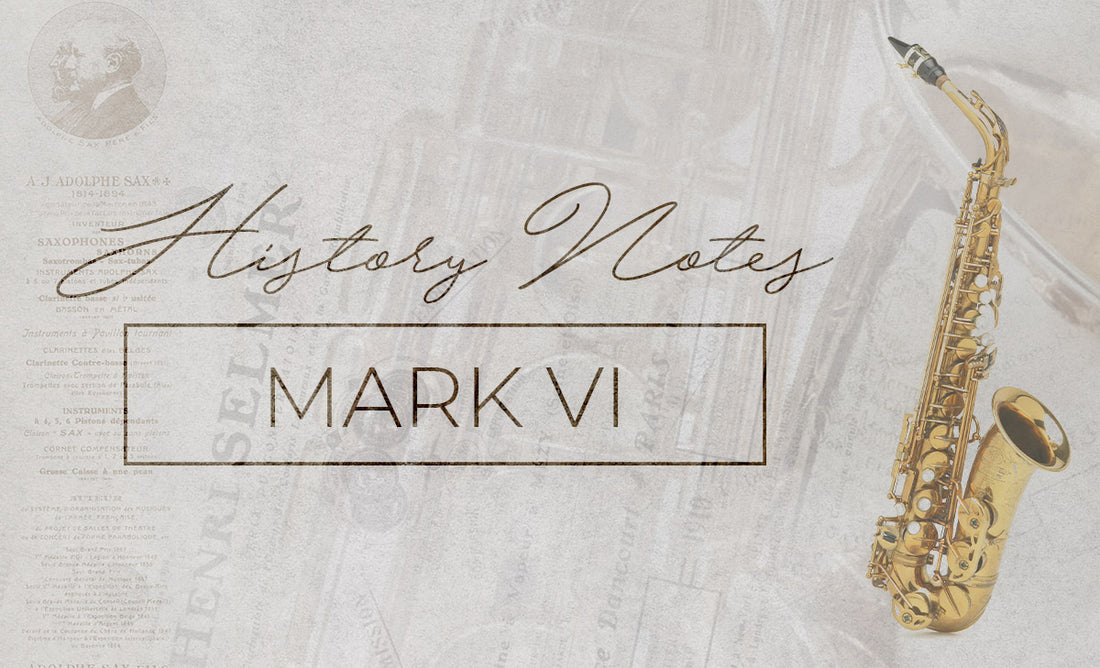History Notes #10: The Mark VI

In the spring of 1954, March 19, to be exact, a single saxophone was packed up and shipped to Selmer US. This instrument number 53,727, was the first Mark VI to be sent. This number was later used in an advertising campaign which said something to the effect of: if your saxophone has a serial number lower than 53,727 you are missing out on many of the great features that the Mark VI offers. And there was a lovely picture of a tenor saxophone. This is great, it's a terrific advertising campaign, but this is a perfect example of why there is so much confusion about Selmer history.

First of all, 53,727 was an Alto, not a tenor. Secondly, 53,727 was not the earliest serial number, just the first one sent to the US. Thirdly, 53,727 was not the last of the super actions. In the next 1000 instruments, only about 56 of them were Mark VI. The other 944 were super actions.
In 1952, around the 49,000 serial number Mark, some Mark VI prototypes started appearing. In the early 54,000, small production test runs start appearing. By 55,000 Mark VI is running pretty well, full stream. So in general the Mark VI tenors got running around 54,500, the Altos around 55,000, the baritones closer to 56,000, and the Sopranos actually didn't take on the Mark VI aspects until almost 70,000, the very late 69,000 range.
The name Mark VI was actually an American marketing idea, much like the balanced action and the super action which were both American names. The Mark VI seems to have come from and it makes sense to think of it as the 6th generation of selmer saxophone: the 22, the 26, we'll conveniently ignore the Large Bore which was kind of in there, the Super series, the Balanced Action, the Super Action, and the Mark VI.
Henri SELMER Paris did not put any Mark VI identification on their instruments for the first eight years or so. There's a really interesting way to tell if your saxophone is a US market instrument or not. If it has the Mark VI engraved, not stamped, but engraved on the instrument, that engraving would have happened in Elkhart, Indiana. If you have a Mark VI between serial number 55,140 thousand, that doesn't say Mark VI at all anywhere, it is a non US market. It could be Canadian, it could be British, it could be European, it could be South American, but those are non US markets.

Starting around 1410 serial number, the Altos and tenors received their first Mark VI stamp in France. This was a very small stamp put vertically on the upper body. If you look closely at this stamp, it's the same exact die that was used on the Sopranos from about 1963. So the very first French Mark VI identification was on the Sopranos. The second was a vertical stamp in the body just from 141 to 143, so only for about four months of production. At the end of this time, Henri SELMER Paris had a stamped Mark VI put in the Bell bow band. So for any saxophone after this worldwide, they all have the stamp Bell bow band.
But you can still tell if it's an American saxophone or not : the original Copyright for the word Mark VI was an American Copyright. So the Americans on every instrument they received from 1430 right up to the end of Mark VI and through to Mark VII as well, they engraved a registration Mark, the R with a circle around it after the stamped Mark VI. So if you have a saxophone that just has a stamped Mark VI and no registration Mark, it's non American market. If it has the engraved registration Mark, it' an American market instrument.

So what do I mean by an American market Mark VI? The way selmer Paris shipped saxophones to Selmer US was they were fully assembled, all the keys were on, pads were stuck in but the pads were not permanently there and the instrument was not set up. They were shipped four to a crate with the necks separate as in packed into a small box in the same crate. So there would be four necks and four saxophones fully assembled. Once they arrived in Elkhart they would be disassembled padded, engraved lacquered or plated - but most almost all were lacquered in the American dark style lacquer - and then finally set up. So it's not technically accurate to say that there are American assembled saxophones. They're more American setup saxophones because all instruments, every single Henri SELMER Paris saxophone was built at the factory in Mantes-la-Ville, France.
One other differentiation between the American market Mark VI and the European market Mark VI was when the Americans did take the Horn apart to Pat it and put it back together, they took the bow off and actually soldered the bow to the body. The European market did not have this done. So there is a key difference.
► Subscribe to our youtube channel so you don't miss any episode
► Next episode: Mark VII
► Discover History Notes as a podcast